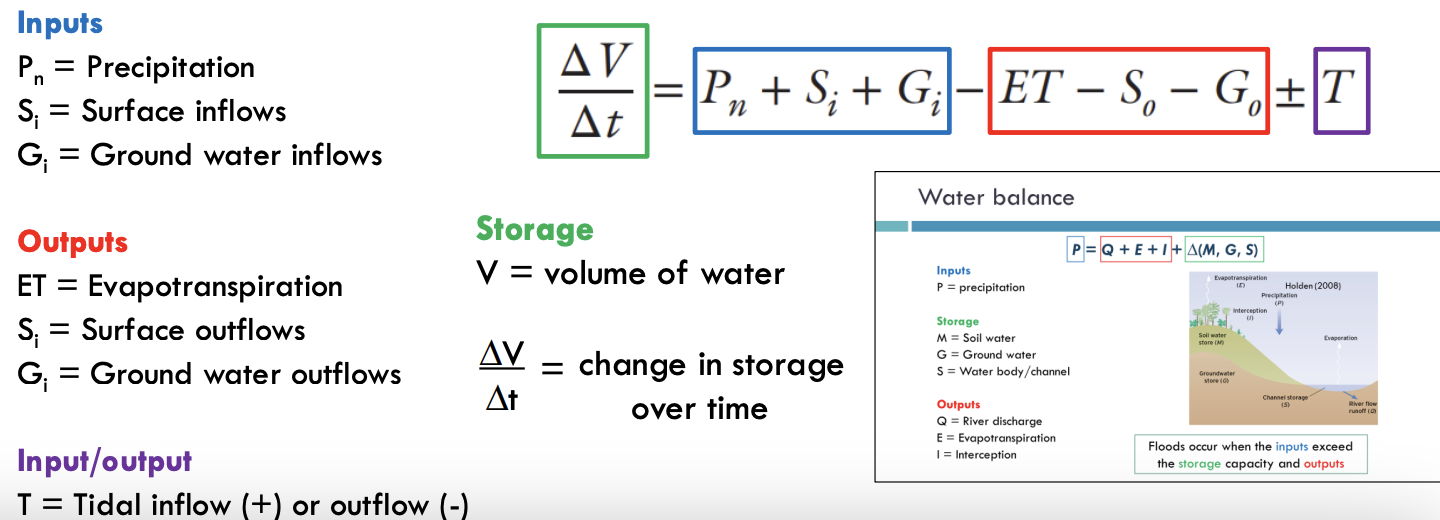Dynamic Earth 4-6
1/54
There's no tags or description
Looks like no tags are added yet.
Name | Mastery | Learn | Test | Matching | Spaced |
|---|
No study sessions yet.
55 Terms
What is a slope>
• Slopes are the basic elements of landscapes – Up to 90% of land not under oceans or ice are hillslopes – Source of sediment and nutrients • Heavily managed • Source of hazards • A key focus of much theoretical and empirical research.
Factors affecting slope processes-
Tectonic activity— endogenic
nature of materials of slope
slope angle/ relief
weathering
vegetation — exogenic
When does mass movement occur and what is the equation
Mass movement occurs when stress > strength

when B is increased N=S and forces are balanced
Angle B increased further N<S- Risk of movement
What is sheer strength
Shear strength is related to cohesion and effective normal stress (σ) by the Coulomb-Terzaghi equation:
𝑆𝑆 = 𝐶 + 𝜎 tan𝜑
SS = shear strength of slope material
C = cohesion σ = effective normal stress tan
φ = coefficient of internal friction
Factor of safety equation
Shear strength / Shear stress
Where safety factor > 1.3, slope is stable
Where safety factor < 1, slope is actively unstable
Where safety factor 1 – 1.3, slope is conditionally unstable
What are the contributing factors of slope instability
Shear stress factors- Removal of lateral support, loading of slope, lateral pressure and transient stresses
Reduced shear strength factors- weathering, changes in pore-water pressure, changes of structure and organic effects
What is the classification fo mass movements
Mass movements are typically classified based on:
▪ the type of movement
▪ the type of materials involved
▪ the rate of movement
▪ the volume / size of materials
Speed of mass movements
This is called creep
Creep is the very slow downslope migration of soil and loose rock fragments. One cause of creep is frost wedging. Freezing lifts particles at right angles to the slope, and thawing allows the particles to fall back to a slightly lower level. Thus, each cycle moves the material a short distance downhill.
Rockfall (M/S)
Individual blocks drop in a free fall from a cliff or steep mountainside. Can be highly destructive. Limited transport distance. Facilitated / triggered by a range of factors (temperature, freeze-thaw, exfoliation, weathering, tectonics).
What happenned in Chamoli (2021)
A large rock and ice avalanche (27,000,000 tonnes; 76,455,495 m3 ) Sourced from a steep rock wall and hanging glacier
> 200 fatalities, dam collapse
“…rapidly transformed into an extraordinarily large and mobile debris flow that transported boulders greater than 20 meters in diameter and scoured the valley walls up to 220 meters above the valley floor. (Shugar et al. (2021)
Preparatory factors ▪ Steep slope (35°) and height difference (~3700 m) ▪ Rock (80%) and ice mixture (20%) → potential for liquefaction ▪ Fractures within the rockwall ▪ Climate change e.g., degrading permafrost or glacier shrinkage (uncovering/destabilising mountain flanks) ▪ Geological weaknesses (weathering) Triggering factors ▪ Pore-water pressures/freeze thaw ▪ Earthquake?
What does senecent mean
old/ aging
What are the key ingredients in trees
Leaves- Photosyntheisi, carbon fixation, contain: chloroplasts and stomata
Wood- Growth and water transport- Xylem- Cellulose and lignin
Roots- Anchorage and nutrient acquisition- (mycorrhizare)
Facts about forests
Dominant terrestrial ecosystem on Earth-
30% of the land area
75% of terrestrial primary production
80% of Earth’s biomass
80% of Earth’s Terrestrial biodiversity
Impacts forests have on the Earths system
Biological – ecosystems, biodiversity
Biophysical – land cover and climate feedbacks
Biogeochemical – carbon, nitrogen, nutrient cycles
What value to forests bring to us

Ecological services Provisioning services Regulating services Cultural services
What is dieback?
“an episodic event characterised by premature, progressive loss of tree and stand vigour…”
“…without obvious evidence of a single clearly identifiable causal factor” (Ciesla and Donaubauer, 1994)
Synonyms: decline, forest dieback, stand level dieback, canopy dieback
What are the symtoms of die back>
Reduced growth
Chlorotic (yellowing) foliage
Death of twigs and branches Root necrosis Tree death
Tree-to-Tree vs. Salt-and-Pepper
Tree-to-tree dieback – many adjacent trees affected
Salt-and-pepper dieback – dying trees in a matrix of healthy trees
Eucalyptus Marginata
“Jarrah dieback” since 1940s in SW Australia
Crown decline, foliar wilt, root death, tree mortality
20,000 ha / yr affected in 70s and 80s
Dieback also reported in >50 other species
What is Fraxinus Excelsior (Common ash)
Chalara ash dieback in Britain since 2012.
Olea Europaea (olive)
Xyella Fasatidiosa- Bacterial Pathogen of olives
Originating in the Americas, discovered in 2013 in Italy then Corsica in 2015 and spain in 2017
What are the drivers of Dieback
Climate stress- higher temps, trade off for less water and effective photosyntheisi, long term stress and acute injury
Pests and pathogens- Native and invasive
Soil degradation
fire regimes
Pollution- Acid rain
Human land use- Summer heat, disrupted seasonal cycles, storms and rain fall
hydrological changes
Competition and overgrowth
How to categories causes of forest dieback
Biotic or abiotic
Natrual or anthropogenic
Chronic or episodic
Internal or external
Healthy trees shouldn’t die Stress generally precedes dieback Stressed trees more likely to die from secondary effects that aren’t fatal to healthy trees
Synergistic effects of forest dieback
Synergy: interaction of two or more agents to produce an effect greater than the sum of their separate effects
Consider: Drought stress + bark and beetle attack
acid rain _ soil nutrient leaching
Fertilisation + insect defoliation
What is the conceptual model for dieback?
Predisposing, Inciting and Contributing Factors Predisposing: long term factors that weaken trees Inciting: short term physical or biological damage/injury Contributing: ongoing factors that ultimately kill
Mountain pine beetle
Dendroctonus ponderosae Bark beetle (subfam. Scolytinae) Native to western North America Life cycle depends on pine trees Inhabits multiple Pinus species, including P. ponderosa, P. contorta, P. flexilis…
What kills them>
Blue stain fungus
Symbiosis with MPB
Prevents healing of wood tissue damage
MPB is a native species
MPB prefers mature and old trees, and should help to remove weak individuals
Cold temperatures in mountain areas should limit the size and activity of MPB populations
Natural forest regeneration cycles should limit the number of suitable trees for MPB
Largest epidemic of MPB in history
Extending from Yukon Territory to New Mexico
13 million ha (130,000 km2 ) of trees killed in British Columbia
MPBs migrating upwards (elevation and latitude)
Ongoing for over a decade
Synergistic factors in MPB Epidemic
Wildfire reduction – higher proportion of old trees
Drought stress – trees more vulnerable, internal defence mechanisms weakened
Warming temperatures
Warmer winters – greater overwintering survival of MPB
Warmer summers – range extension into new areas (with lower genetic resistance to MPB)
Longer summer season – larger window for flight and attack + changes to reproductive cycle
What are the impacts of forest die back the on the ESS
Biodiversity Vegetation composition Ecosystem function
Consider MPB forest dieback… 13 million hectares of MPB-killed trees in B.C. = 900 million tons of CO2 into the atmosphere = 5 x annual transportation emissions of Canada!- Whole regions shift from carbon sinks to sources Positive feedbacks for climate change
Deeper snowpack in dieback areas Faster spring melting Changes to stream discharge, flooding risks and water resources
How to combat dieback?
Monitoring programmes
Phytosanitary inspections
Containment of dieases – transport restrictions, e.g. DEFRA
Treatment of diseased individuals / patches
Destruction of diseased individuals
Irrigation / nutrient regulation schemes
Different solutions at different spatial scales Prevention and management require scientific knowledge of the causes of dieback
What are wetlands
They are a presence of water with unique soil conditions and support unique biota
They have a deoth and duration of flooding, with a varying level of species, location and size
What are the different types of wetlands?
Marshes- frequently/ continually inundated, herbaceous plants, mineral substrate, freshwater saline, high in nutrients
Swamps- Permenantly saturated, trees and shrubs, more organic, freshwater, saline or brakish water, high in nutrients
Peatlands- permenantly saturated, highly organic, freshwater, rain fed, low/ high nutrients
There are two types of models for wetlands in the landscape
Transitional (Deepwater aquatic system) and isolated
Why are wetlands important
Providiing for all the ecosystem services
including- Cultural, regulating, supporting and provisioning services
Wetland degradation example
Mangrove destruction for shrimp farming in southern and SE Asia
Salt marsh dies in the UK and the USA
Drainage of tropical peat swamp forest for palm oil and wood pulp
Disconnecting rivers from floodplains
Clearing boreal peatlands for tar extraction in Canada
What are the wetlands protection on a global level?
Wetlands international, Sustainable development goals
Wetlands protection- regional/ national
ASEAN Programme for sustainable management of Peatland Ecosystems
IUCN- peatland programme
Wetland protection on a local scale
Moors for the future
Yorkshire peat Partnership
Pennine Peat life
What is wetland hydrology>
hydroperiod, water budgets, and biotic feedbacks
and they influence the functions of vegetation composition, primary productivity, the buildup of organic material, nutrient cycling, and availability.
What is a hydroperiod>
The duration and frequency of inundation or flooding in a wetland, essentially the amount of time a particular area of land is wet

What does the hydroperiod show
Balance between the inflows and outflows of water
Surface contour of the landscape
Subsurface soil, geology, and groundwater conditions

What is the correlation between hydroperiod and plant species richness
The increase in hydroperiod means an increase in plant richness
What is the function of wetland hydrology> w
Accumulation of organic material
Nutrient cycle and availability
What does deeper soils result in?
Increasing decomposition/ humification with depth
how do you knwo the minerals that are in soils
Oxidised minerals go orange-tinted
hydrophytic adaptation
Structural/ morphological - includes Adventurous, aerenchyma, stem hypertrophy, and phytotrophs.
physiological- pressurised gas flow, oxygenation, low water uptake, anaerobic respiration.
Whole plant strategies- timing of seed production, buoyant seeds, vivpary, large persistent seed bank
What does succession look like in wetland vegetation
Terrestrialisation and paludification
What chemicals does wetland biochemistry include?
Carbon, nitrogen and sulphur
Mangroves and swamps
Tropical/ subtropical wetlands, inpenetrable woody vegetation, unconsolidated peat deposits, adaptations to flooding, salinity, resilient deiverse ecosystems Mangroves are found in coastal regions in lots of asia and North East south America
Mangroves for coastal protection-
Protects against- tsunami waves, storm surges, storm winds and stems and leaves can attenuate larfe waves. Root structures and steep continental slopes, reefs may reduce of increase wave destructiveness depending on form
Peatlands
Accumulated layer of organic matter at the surface
Permanently waterlogged
Semi-decomposed plant material
Long-term carbon sequestration and storage
Diverse ecosystems
Found in the Northern hemisphere mostly- lots in Canada and Russia
Peatlands and flood control>
Erosion increases catchment flashiness
Increased drainage density and connectivity
Peatland restoration
Lag-time increases
Peak flows decrease
no change in rainfall: runoff
What are artificial wetlands
Nature-based Solutions
actions to protect, sustainably manage, and restore natural or modified ecosystems, that address societal challenges effectively and adaptively, simultaneously providing human well-being and biodiversity benefits
E>G> Laurel Run wetland, Maryland USA
Wetlands and folklore include-
Will-o-the-wisp
Monsters and bogeys
The curse of Tiddy Mun